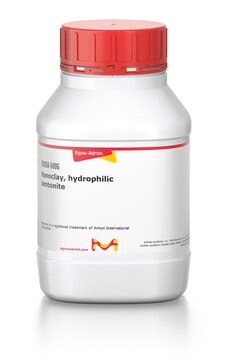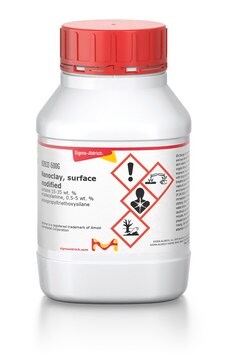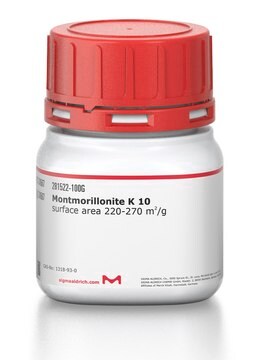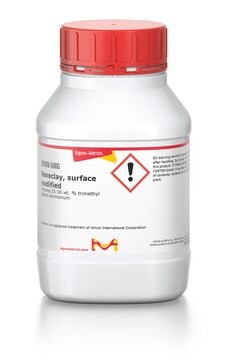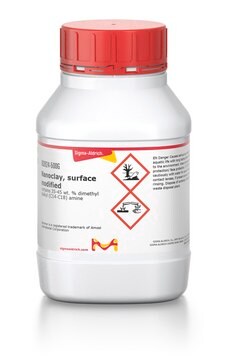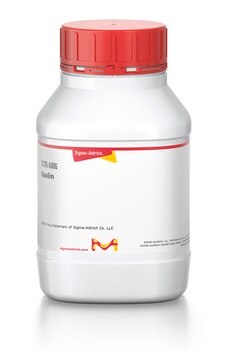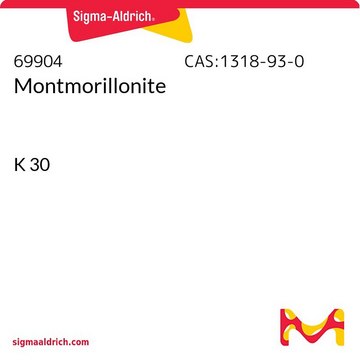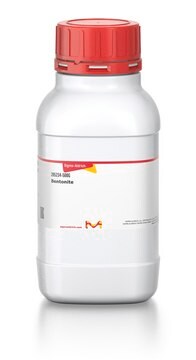685445
Halloysite Nanoclay
Synonyme(s) :
Kaolin clay
About This Item
Produits recommandés
Forme
nanopowder
Niveau de qualité
Diam. × L
30-70 nm × 1-3 μm , nanotube
Superficie
64 m2/g
Couleur
75-96, Hunter Brightness
Indice de réfraction
n20/D 1.54
Dimension de pores
1.26-1.34 mL/g pore volume
Capacité
8.0 meq/g cation exchange capacity
Densité
2.53 (true specific gravity)
Chaîne SMILES
O.O.O[Si](O)(O[Al]=O)O[Si](O)(O)O[Al]=O
InChI
1S/2Al.H4O7Si2.2H2O.2O/c;;1-8(2,3)7-9(4,5)6;;;;/h;;1-2,4-5H;2*1H2;;/q2*+1;-2;;;;
Clé InChI
HEFIDAICLOZRRO-UHFFFAOYSA-N
Description générale
Similar to montmorillonite, halloysite consists of two layers of aluminosilicate in 1:1 Al:Si ratio. Significant improvements in thermal, mechanical properties have been reported on addition of halloysite nanotubes in polymer composites.
Application
Isotactic propylene-halloysite nanocomposites.
Alloy composites by electroless/ autocatalytic deposition.
Poly(butylene terephthalate) (PBT) composites.
Zinc–halloysite nanotube (HNT) composite coatings.
Halloysite nanotube–hydroxyapatite–hyaluronic acid films.
Halloysite combined with polyamide, polypropylene, poly(ε-caprolactone) and fluroelastomers.
Its tube like morphology, high aspect ratio, and low percolation enables interesting applications as reinforcements in nanocomposites.
Informations légales
Code de la classe de stockage
11 - Combustible Solids
Classe de danger pour l'eau (WGK)
nwg
Point d'éclair (°F)
Not applicable
Point d'éclair (°C)
Not applicable
Équipement de protection individuelle
Eyeshields, Gloves, type N95 (US)
Faites votre choix parmi les versions les plus récentes :
Déjà en possession de ce produit ?
Retrouvez la documentation relative aux produits que vous avez récemment achetés dans la Bibliothèque de documents.
Les clients ont également consulté
Articles
Graphene is a one-atomic-layer thick two-dimensional material made of carbon atoms arranged in a honeycomb structure. Its fascinating electrical, optical, and mechanical properties ignited enormous interdisciplinary interest from the physics, chemistry, and materials science fields.
Notre équipe de scientifiques dispose d'une expérience dans tous les secteurs de la recherche, notamment en sciences de la vie, science des matériaux, synthèse chimique, chromatographie, analyse et dans de nombreux autres domaines..
Contacter notre Service technique